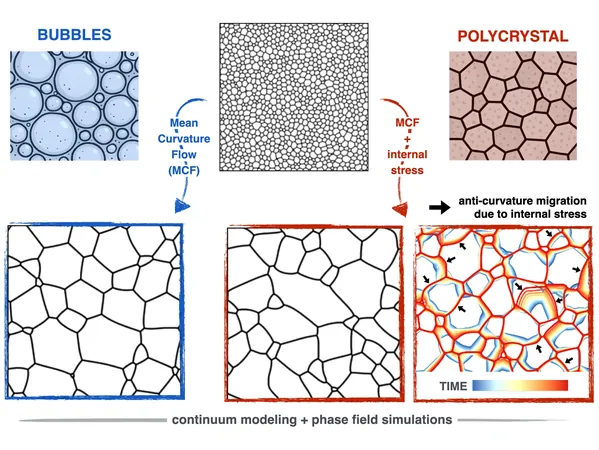
Revolutionary Discoveries in Metal and Ceramic Microstructures: Internal Stresses Redefine Material Science
2025-06-26
Author: John Tan
Unlocking the Secrets of Crystalline Growth
In a groundbreaking study led by Professor Marco Salvalaglio from the prestigious TUD–Dresden University of Technology, researchers have unveiled that internal stresses are not just background noise but pivotal players in the growth of grains in metals and ceramics. This discovery challenges long-standing theories in material science and promises to revolutionize how we engineer new materials.
The Hidden Forces Behind Material Behavior
Polycrystalline materials, composed of countless tiny crystals or grains, are ubiquitous in nature and technology—from the formidable rocks of our planet to everyday metals and innovative ceramics. The arrangement and evolution of these grains hold the key to vital properties such as strength, flexibility, and electrical conductivity. Unraveling the mechanisms that drive these changes is crucial for crafting materials tailored for specific applications.
Shear Coupling: The Game Changer
Through cutting-edge computer simulations and theoretical modeling, Salvalaglio's team reveals a mechanism known as "shear coupling," where internal mechanical stresses emerge as grain boundaries shift. This process significantly impacts microstructure evolution, causing growth patterns to diverge from traditional predictions. Such insights could explain the mysterious behaviors observed in real polycrystals.
Implications for Engineering and Technology
These revelations not only clarify why certain materials behave unpredictably but also hold the potential for designing advanced materials—from ultra-strong metals to state-of-the-art electronic components. The research accentuates the unique ability of crystalline materials to withstand significant deformation, setting them apart from other systems like foams or emulsions.
Looking Ahead: A New Research Frontier
Salvalaglio emphasizes the importance of this research, stating, "Our exploration of internal stresses in polycrystalline microstructures began a few years ago, aiming to bridge gaps in existing theories. It’s thrilling to see our efforts yield insights that reconcile past experimental mysteries and propel updates on classical models." He outlines plans for future investigations, including examining interactions with plastic relaxation within grains and exploring behavior in more complex, multi-component materials.


 Brasil (PT)
Brasil (PT)
 Canada (EN)
Canada (EN)
 Chile (ES)
Chile (ES)
 Česko (CS)
Česko (CS)
 대한민국 (KO)
대한민국 (KO)
 España (ES)
España (ES)
 France (FR)
France (FR)
 Hong Kong (EN)
Hong Kong (EN)
 Italia (IT)
Italia (IT)
 日本 (JA)
日本 (JA)
 Magyarország (HU)
Magyarország (HU)
 Norge (NO)
Norge (NO)
 Polska (PL)
Polska (PL)
 Schweiz (DE)
Schweiz (DE)
 Singapore (EN)
Singapore (EN)
 Sverige (SV)
Sverige (SV)
 Suomi (FI)
Suomi (FI)
 Türkiye (TR)
Türkiye (TR)
 الإمارات العربية المتحدة (AR)
الإمارات العربية المتحدة (AR)